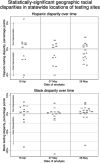Racial and ethnic inequities in the early distribution of U.S. COVID-19 testing sites and mortality
- PMID: 34390487
- PMCID: PMC8420583
- DOI: 10.1111/eci.13669
Racial and ethnic inequities in the early distribution of U.S. COVID-19 testing sites and mortality
Abstract
Background: In 2020, early U.S. COVID-19 testing sites offered diagnostic capacity to patients and were important sources of epidemiological data about the spread of the novel pandemic disease. However, little research has comprehensively described American testing sites' distribution by race/ethnicity and sought to identify any relation to known disparities in COVID-19 outcomes.
Methods: Locations of U.S. COVID-19 testing sites were gathered from 16 April to 28 May 2020. Geographic testing disparities were evaluated with comparisons of the demographic makeup of zip codes around each testing site versus Monte Carlo simulations, aggregated to statewide and nationwide levels. State testing disparities were compared with statewide disparities in mortality observed one to 3 weeks later using multivariable regression, controlling for confounding disparities and characteristics.
Results: Nationwide, COVID-19 testing sites geographically overrepresented White residents on 7 May, underrepresented Hispanic residents on 16 April, 7 May and 28 May and overrepresented Black residents on 28 May compared with random distribution within counties, with new sites added over time exhibiting inconsistent disparities for Black and Hispanic populations. For every 1 percentage point increase in underrepresentation of Hispanic populations in zip codes with testing, mortality among the state's Hispanic population was 1.04 percentage points more over-representative (SE = 0.415, p = .01).
Conclusions: American testing sites were not distributed equitably by race during this analysis, often underrepresenting minority populations who bear a disproportionate burden of COVID-19 cases and deaths. With an easy-to-implement measure of geographic disparity, these results provide empirical support for the consideration of access when distributing preventive resources.
© 2021 The Authors. European Journal of Clinical Investigation published by John Wiley & Sons Ltd on behalf of Stichting European Society for Clinical Investigation Journal Foundation.
Figures



References
-
- Centers for Disease Control and Prevention . Cases of Coronavirus Disease (COVID‐19) in the U.S. Published online 2020. https://www.cdc.gov/coronavirus/2019‐ncov/cases‐updates/cases‐in‐us.html
MeSH terms
LinkOut - more resources
Full Text Sources
Medical
Miscellaneous

